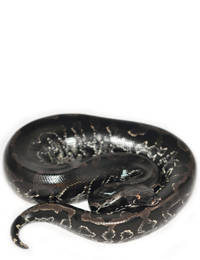A variety of snake species are found in the UAE, most are not venomous, unlike the horned viper (Cerastes cerastes gasperetii), which is similar in appearance to the false horned viper (Pseudocerastes persicus), and is often also referred to as the sand viper. Confusion arises because only some have horns. The horned viper reaches a length of about 85 centimeters, and has the typical stocky viper body, a very broad head with hinged teeth. Horned vipers also move in a side-winding manner in soft sand, which is their favoured habitat. Adapted to the open desert it is creamy-beige in colour, with darker blotches on its back. In the Emirates it is found in all the sandy deserts from the coast up to the mountain plains where there is virtually no shade available.
The horned viper is almost entirely nocturnal, spending the day under anything that provides a little shelter from the sun. If no shade is available, it buries itself in the sand by moving its ribs forward, and at the same time upward, causing the sand to be pushed to the side and allowing the otherwise motionless animal to sink below the surface in a manner reminiscent of a submerging submarine. Within a very short time nothing is visible but the eyes, which are set very high on top of the viper’s head.
 |
 |
 |
 |
Biology:
Snakes are ectotherms, meaning that a snake regulates its body temperature by taking heat from or giving off heat to the environment. Because their body temperature is affected by environmental temperatures and varies with surrounding conditions, snakes become inactive during very hot seasons (aestivation) and very cold seasons (hibernation). Snakes may go for several weeks without eating because of frequent periods of inactivity.
Because they are cold-blooded, snakes must rely on behavior to regulate their body temperature. During the hot part of the day, snakes move to shaded areas, and on cool days they sun themselves on rocks or in warm open areas. Snakes often seek out paved roads where they are attracted by the heat from the road surface.
Because snakes have backbones, they are classified in the same group (vertebrates) as fish, mammals, birds, and people. The snake's skeletal system is unique. Snake bones are very light and highly movable. The lower jaws and skull are connected by a piece of stretchy material (ligament). This allows the snake to open its mouth very wide and move each jaw independently. Thus, a snake can swallow prey much larger than its head by “walking” its mouth around the food from side to side in a forward movement.
Snakes are very specialized animals. They do not have legs, ears, or eyelids. There are no “walking” snakes. Often the sex organs of a snake may protrude from the anal plate area and are confused with legs.
They use their forked tongues to smell. The tongue is constantly flicking to pick up airborne particles and odors. Once these aromas are detected, the snake inserts its tongue into two holes in the top of its mouth (Jacobson's organ), where the smells are interpreted by its brain. If the snake detects food and it is hungry, it will pursue the animal.
Contrary to popular belief, snakes are not slimy. In fact, they feel dry to the touch. The snake's scales and skin help keep it from losing moisture from its body. Snakes shed their skin and eye covering together.
When threatened, many snakes produce a unique scent from musk glands located near the anus. Copper belly water snakes smell like skunks, while rat snakes and copperheads smell like cucumbers.
Soon after the temperatures rise during spring, snakes come out of hibernation and mate. Some snakes lay eggs in a damp, protected area where they will hatch in about two months. Other snakes hatch eggs inside the body. Copperheads, rattlesnakes, cottonmouths, garter snakes, and water snakes give birth to live young. If you find snake eggs around your home or garden, there is no cause for concern because they were laid by a harmless snake. Once the young have been hatched or born, the parents do not care for their offspring because they are able to take care of themselves.
All snakes are predators, and many are very fussy eaters. Ratsnakes eat rats, mice, and chipmunks. Water snakes feed primarily on dead, diseased, or injured fish. King snakes feed on other snakes, mice, young birds, and bird eggs. Some small snakes, like the rough green snake, eat insects, while others (earth snakes and worm snakes) eat earthworms, slugs, and salamanders. Toads are the favorite food of hognose snakes.
When people encounter a snake, they often corner it. Then the snake will hiss loudly, open its mouth in a threatening manner, coil up, and strike at the individual-or bluff by advancing toward the intruder. These behaviors, designed to scare off the intruder, lead to a common misconception that snakes charge or attack people. In most cases, a snake reacts only if it feels threatened. Usually it crawls away if it can reach cover safely. One exception is the male black racer, which may chase after larger animals, including humans, when it is defending its breeding territory.


